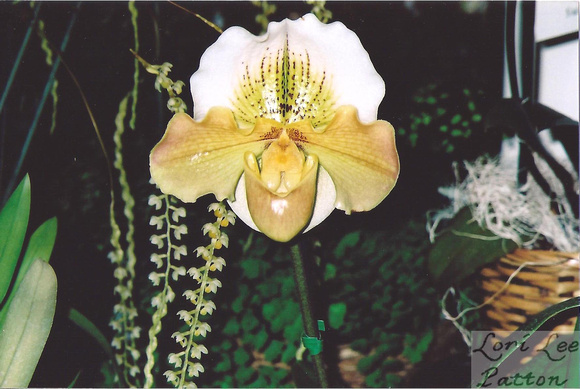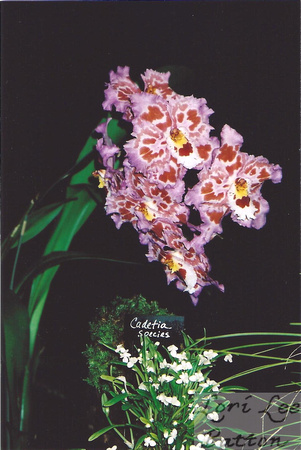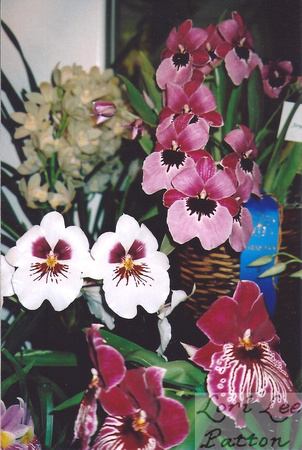Exploring Exotic Orchids
Orchids have always held a certain mystery for me. They are not typical garden flowers and can be rather difficult houseplants to maintain. Although I have been an avid gardener and once boasted over 20 indoor plants, orchids were not among them. It wasn’t until I started working for an advertising agency in Portland, Oregon that I first became acquainted with these unusual flowers. The agency had a florist specializing in orchids bring new arrangements for the office every month. I was fascinated by the wide variety of orchids both in terms of shape and color patterns. Recently, I decided to delve into the botanical history of orchids to reveal the secrets of their exotic beauty.
There are approximately 25,000 orchid species with over 155,000 hybrid varieties. To make this mind-boggling number more manageable, I’m going to focus on three genera that I find captivating. The first is the paphiopedilum genus, more commonly known as lady’s slipper orchids. The photo of the yellow and white orchid shown above is one of these specimens. Native to southern Asia, paphiopedilums were named by the German botanist Ernst Hugo Heinrich Pfitzer. Since orchids had been associated with the Greek goddess of love, Aphrodite, whose legendary birthplace was Paphos, Pfitzer incorporated this myth into the genus name. Thus, paphiopedilum combines the Greek words Paphos with pedilon, meaning slipper (lady’s slipper orchids). Distinguishing features of these orchids are their lacquered appearance and unusual color combinations. Also, their lips resemble a pouch or toe of a slipper, hence the name. In the photo above, notice the white sepal with yellow pattern containing brown speckles and a vertical green streak. The mustard petals and lip also have a mottled brown pattern and glossy finish. The intricate design of this flower is like a work of art and lends itself beautifully for photographic enlargements. Caring for lady’s slipper orchids is a challenge, however, as they require nighttime temperatures of around 50 degrees along with 50 percent humidity.
Another orchid that I find particularly lovely is the odontoglossum, native to South America. The photo “Exotic Orchids” shown above features dusty pink blooms with brown and white splotches surrounding yellow columns. The column is the area in the orchid’s center that receives pollination and is what distinguishes orchids from other flowers. Notice the pretty ruffled edges of the petals, which add to its whimsical appearance. These Columbian odontoglossums grow in the Andes Mountains at elevations up to 10,000 feet. Therefore, they require very cool growing conditions with nighttime temperatures around 45 degrees and humidity up to 70 percent to simulate the mountains’ foggy environment. Unless one has a special climate controlled room, it would be difficult to grow these orchids successfully. The small white orchids shown at the bottom of the photo are of the unrelated cadetia species. These are a great example of the diversity of orchids as they are so different from the more well-known varieties. The dainty cadetia flowers also provide an attractive contrast to the showy odontoglossums, as well as a welcome burst of white against the dark background.
My favorite orchids also belong to the odontoglossum tribe but are of the separate miltonia genus. These delightful flowers, shown in the photo “Prize Pansy Orchids” above, first caught my eye when I attended the Oregon Orchid Society’s annual show. They look a lot like pansies – a common garden flower I’ve planted many times – but are more elegant and have fancier patterns. However, while pansies are very easy to grow, miltonias are temperamental. As they also originate from Columbian cloud forests, they require similar climate conditions as odontoglossums. I admire those growers who are able to replicate this environment to raise such beautiful specimens. The pink miltonias, awarded the blue ribbon in the photo, are the hybrid Joyce Goldfarb. All hybrid names are maintained by the Royal Horticultural Society in England.
The variety of orchids – one of the world’s largest plant families -- is truly amazing. Due to their particular growing requirements, one of the best ways to enjoy them is by placing some orchid photographs in your home or office. Whether you prefer the cheerful pansy orchids, the lovely lady’s slipper orchids, or the exotic odontoglossums, you will have a bit of beauty to brighten your living space year-round.
Sources
James, I.D. Orchids. Buffalo: Firefly, 2001.
Kramer, Jack. Orchids. Ed. Kathryn L. Arthurs. Menlo Park: Sunset, 1977.
Potter, Jennifer. Seven Flowers and How They Shaped Our World. New York: Overlook Press, 2014.



